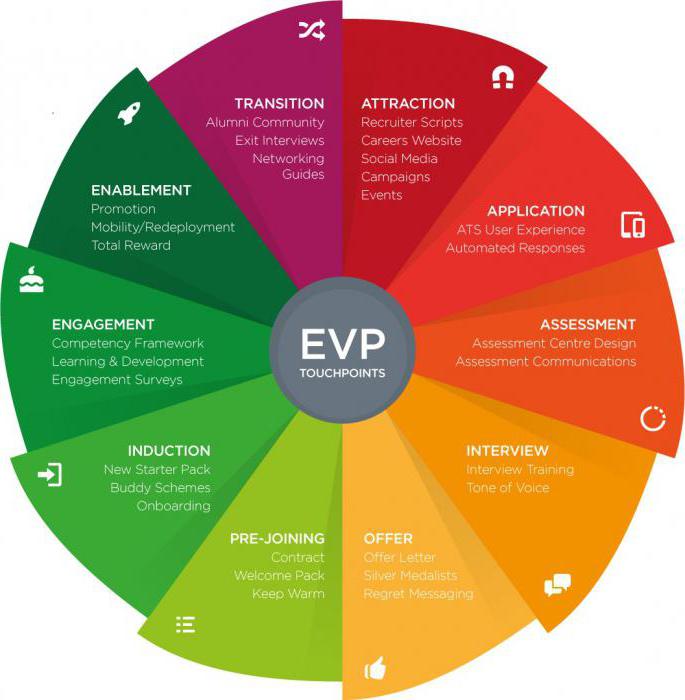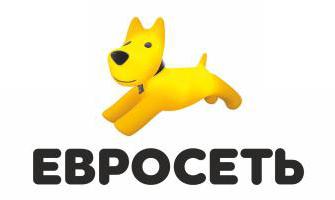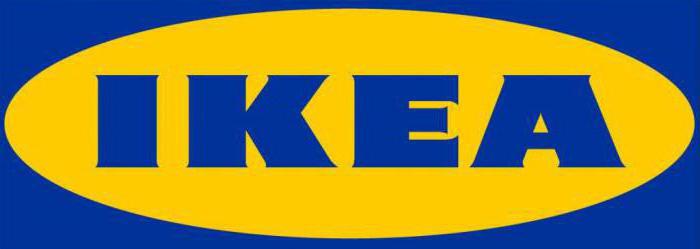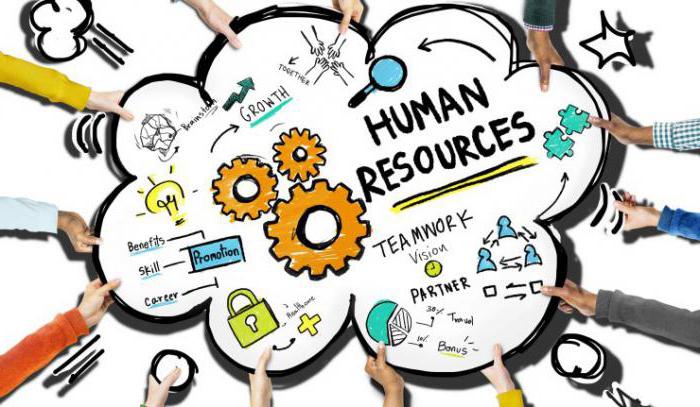The term "HR-branding" appeared recently, in 1990, when T. Ambler and S. Burrow published their first studies on this topic. However, every year more and more attention is paid to him, especially in large corporations with a worldwide reputation. What is an employer brand and why do you need to create it?

Definition and essence of the concept
An employer brand is a set of functional, economic as well as psychological benefits that are provided by the management of a company and associated with it. In simple terms, we can say that this is the image that the company has in the eyes of applicants and their own employees.
The brand of the company as an employer largely affects its success. In the modern world, there is a huge demand for qualified personnel, which, due to demographic changes, is exacerbating every year.
Many authors of business books emphasize the importance of competent selection of employees. So, in his bestselling book From Good to Great, Jim Collins claims that company leaders who managed to reach a whole new level always started by “taking the right people into their bus.”
The most valuable resource these days is people. To win in a competitive race, each company tries to attract as many skilled, experienced and interested employees as possible. And the task of HR branding is to convince them that this company is the best place to work.

Why is the image of the employer so important?
Unfortunately, many enterprises, especially in the post-Soviet space, are generally not very interested in such issues. They have no problems finding a person for a particular position, and dozens of people ready to work for even 10,000 rubles go through the personnel department every day ... However, this is an extremely superficial look.
Companies that do not pay due attention to recruitment suffer tremendous losses, especially financial ones:
- damage from failure to fulfill production plans due to lack of trained personnel;
- losses from low productivity of inexperienced employees;
- frequent repairs of equipment due to unqualified actions of the maintenance staff;
- expenses for the constant search for "leaking" personnel;
- training and staff training costs.
What is the result? New employees in such a company leave without even having time to compensate for the costs of their search and training, or go to work for years without any benefit and become a “black hole” in the budget.
At the same time, the development of the employer's brand allows you to:
- to attract the attention of the best candidates;
- to find the most qualified, spending much less effort;
- retain key employees within the company;
- reduce costs caused by staff turnover;
- Increase employee engagement, thereby achieving higher levels of productivity and customer satisfaction.
Thus, a strong, powerful HR-brand allows the company to reach a higher level by attracting the best personnel.

Brand Stages
Why do some companies want to work in some companies, but go to others, "until there is a better option"? Let's see how the formation of an employer brand in practice occurs.
Stage 1. Creation of a working group
The fate of the HR brand depends on how qualified employees will be engaged in research and planning. Who must be on your team?
- HR (Human Resources Manager).
- Marketer.
- Managers at different levels.
Together, they are able to conduct a full-fledged study of the attractiveness of the company for applicants, as well as organize competent promotion of the employer's brand.

Stage 2. Internal and external research
At this stage, it is necessary to answer the basic questions. What working conditions await highly qualified personnel? Who will they want to work with in the face of fierce competition from employers? How to keep workers?
To find out, internal and external studies are conducted.
Internal is necessary in order to find out what makes a company special in the eyes of its employees. It is important to find out what they like about the organization, what unwritten rules they adhere to, which, in their opinion, can be called brand symbols.
External research is a survey of specialists in this industry, which helps to get real information about how popular the employer's brand is, what factors play the most role in choosing a job and what position the company occupies in comparison with the leader / main competitors.
A lot of useful information can be obtained from the results of open research:
- Student Employer Of The Year (assessment of the external attractiveness of companies among graduates and university students).
- Employer Brand Benchmarking Research (assessment of the attractiveness of employers by industry among specialists and senior specialists with experience of more than 1 year).
After analyzing the data, you will understand what the ideal employer looks like from the point of view of job seekers, what salary they expect, and how you can hook them.

Stage 3. Development of a Value Proposal for Employees (CPC)
First of all, it is necessary to decide what should be associated with the organization as an employer in the first place. For this, it is necessary first of all to clearly understand the mission and strategy of the company, its place in the market, as well as highlight the target audience.
To create an effective DSP, it is necessary to know which factors of the choice of a company as an employer are the most significant. According to EBBR-2011, 87% of respondents ranked first in terms of salary. In addition, the choice of place of work is affected by:
- opportunities for professional and personal growth;
- prospects for climbing the career ladder;
- official employment and official white salary;
- comfortable working conditions;
- training;
- corporate culture;
- convenient work schedule;
- availability of benefits;
- office near home / in the city center, etc.
Thus, first of all, it is necessary to create the image of a stable company with high salaries and bonuses, conditions for development and a friendly team. A huge bonus is the ability to work on a free schedule and realize your creative potential. However, keep in mind that depending on the industry and the specific target audience, priorities may vary.

Stage 4. Communication
The next step is, in fact, the promotion of the employer's brand. At this stage, it is necessary to ensure that potential (and already working) employees learn about the company, its principles and values, and form a certain image.
It is important to choose and use effective communication channels. Nowadays, most of them are carried out on the Internet - through the company's corporate website, posting branded vacancies, e-mail newsletters, YouTube channels, pages on social networks. Presentations at universities, job fairs and other events of this kind also remain relevant.
Step 5: Measure Results
To understand how effective the campaign is, special indicators are used:
- Assessment of the HR brand by key attractiveness factors (salary, career growth, social package, etc.).
- The number of candidates for 1 vacancy and their skill level.
- The cost of closing a vacancy.
At the same time, an analysis of internal indicators is carried out.Most of the information is obtained from surveys among employees. In addition, they analyze the degree of personnel involvement and its relationship with the level of customer satisfaction, the dynamics of staff turnover, loyalty to the company (a sense of ownership, pride).
Also at this stage it is important to carefully study the reasons for the dismissal of workers. Why are they leaving? What can be done to reduce the outflow of specialists?

Branding an Attractive Employer: A Basic Model
One of the first HR brand building models was proposed by Simon Barrow. in the mid 90's. At that time, the researcher worked for People in Business, a company providing consulting services in the field of personnel management. The Wheel model included 12 components of the employer's brand. Among them - employment, development, external reputation, production conditions, performance monitoring, etc.
Later, in collaboration with Richard Mosley, Barrow proposed an improved version of his "Wheels" - an employer brand mix. There are also 12 key factors. The authors divided the components of the brand into two large subgroups.
"Political" (corporate) factors.
- External reputation. Anyone wants to identify with a prestigious brand, a well-known and successful company.
- A clear strategy and value system. There are many studies demonstrating how an employer's brand affects corporate culture. Employees of the company should know how the organization positions itself in relations with customers, and comply with this image.
- Systems of internal evaluation. In order to create a strong internal employer brand, it is important to read employees' opinions on issues related to external communications. On the one hand, it gives a sense of “contribution to the common cause,” on the other hand, it opens up the opportunity to get a fresh look at problems and new ideas.
- The work of senior management. It is managers who determine the relationship between different departments and divisions, and, consequently, the work of the company as a whole. Accurate orders, a clear work plan - all this is extremely important for building a brand.
- Corporate social responsibility. According to research by the Future Foundation, 20% of specialists consider companies that are active in social activities to be more attractive.
- Support at work. Employees want to feel protected, and to know that in this company they will receive the necessary support - not only financial, but also psychological, professional, etc.
Practical factors.
- Employment and introduction. It is at this stage that the values of the organization are inculcated to the employee, a kind of “compatibility test” takes place, grinding in. It is important to create conditions under which the specialist will immediately feel at ease and will not feel discomfort.
- Team communication. Confidential atmosphere, openness and willingness to dialogue, the possibility of delegating tasks - all this is extremely important for the formation of daily job satisfaction.
- Performance control. All tools and evaluation criteria should be closely linked to the company's core values and mission. It is important that they exist not only "in words", but also find their reflection in everyday work.
- Development and training. It is believed that this factor is in second place in importance after the quality of senior management. Studies confirm that employees who have a chance to improve their skills begin to realize their value to the employer, which becomes the foundation for building long-term relationships.
- Reward system. It is worth emphasizing that in the modern theory of monetary motivation management less attention is paid.Due to the high competition in the labor market, employers are constantly forced to invent additional, non-financial "bonuses", to create truly comfortable working conditions (which are just Google or VKontakte offices!).
Brand mix allows you to identify the main areas of work. In order for the “best of the best” to strive to work specifically in your company, you need to work out all the factors that may affect their choice.

Conditions for building a strong HR brand
You need to understand: no matter how you praise your company, placing new vacancies, this is not enough. Studying the experience of organizations that have managed to create the best employer brand, you can track the key conditions that helped them achieve their goals:
- streamlined feedback process - the management examines all reports of problems and rationalization proposals of employees, and introduces appropriate adjustments;
- the presence of a clear and transparent system of motivation (tangible and intangible);
- An understandable system for evaluating employees with specific criteria, on the basis of which all promotions, etc.
- competitive salary level;
- the existence of an effective personnel training system (mentoring, conducting trainings and seminars);
- high degree of awareness - employees are aware of the company's mission, share its values, are aware of all decisions made by the management and current events, which creates a sense of involvement;
- corporate culture.
Contrary to the general misconception, HR branding does not require serious investments. Roughly speaking, if you initially conduct business correctly, and your statements are true, there will be no problems with the selection and retention of valuable employees.

Effective HR Branding Examples
It is best to study employer brand management using concrete examples from practice, exploring the experience of leading companies in various industries. What do they do in order to gather the best specialists "under the wing"?

Perhaps this is one of the most striking examples. Google has managed to create a vibrant HR-brand employer in the market. The corporation strengthens the image of the innovator, supports innovative ideas of its employees and seeks to create a creative atmosphere in which everyone can realize their potential. At the same time, Google is constantly looking for "fresh minds" and conducts a large-scale advertising campaign aimed at potential employees (for example, competitions are regularly held among programmers and designers, various training programs are offered, etc.).

Euroset
A large Russian chain of stores also pays a lot of attention to HR branding. So, in 2006, Euroset received the Re-recruitment Grand Prix, launching immediately 3 projects aimed at creating a positive image of the employer.
To support live communication within the company, a closed portal "Heart-to-Heart Talk" was created, where each employee has the opportunity to speak, complain or ask a question to management, and get a prompt response.
The Samsung Square Meters campaign was launched to motivate sellers, as well as to build a reputation for a company that gives its employees the best material opportunities. The bottom line is simple: for every sale of Samsung phones, an employee was charged square centimeters of future housing space. By the way, the leader of the action managed to earn 21.2 m for an apartment2 in Moscow (more than $ 90,000 in cash).
The third program - EuroDiscount - is an improved social package. Euroset has entered into agreements with popular companies and organizations, thereby providing its employees with significant discounts on their favorite goods and services.

IKEA
“Behind the scenes” of a chain of home goods is also a lot of interesting things.One of the key principles of the company is to do everything so that the time spent by a person at work is not thoughtlessly spent in exchange for money, but is filled with meaning and interesting content.
To attract new employees, IKEA conducts an active campaign on social networks, publishes success stories, photos, and organizes various contests. One of the brightest ideas implemented in recent years is the quest for buyers "IKEA in 300 minutes". Everyone could visit all departments of the hypermarket, and try themselves in the role of different employees - a sales manager, interior designer, warehouse manager, etc.
At the same time, there is no clear subordination in IKEA, the team is built on the principles of democracy and openness (which, of course, requires the personal responsibility of everyone).
The company's HR strategy has already been planned up to 2025. The immediate plans are to relieve applicants of the need to send a paper resume by installing high-tech job kiosks in all stores, where applicants can instantly respond to a vacancy. In addition, in recent years, IKEA has been actively cooperating with career guidance camps, organizing excursions and fascinating quests for children.

Modern trends
In modern conditions, the formation of the employer's brand plays a special role, because between the leading companies there is a real "war for talents". What should be considered when planning a strategy? What works and what doesn’t?
"Make the world a better place together"
It is no coincidence that at every step they say that the company must have a clear mission. People with extraordinary intellect, able to move forward, tend to work in companies that are not engaged in mechanical money making, but carry some kind of idea, create something truly important and useful, make the world a better place.
First-hand stories
Beautiful brochures and flashy advertising texts in the spirit of "We are the best!" these days almost no response. Potential employees want to know how they actually work in a particular company. That is why all kinds of interviews with employees, vivid photos of comfortable offices, blogs on Instagram and other social networks are of great interest.
Money is not the main thing
The presence of a large house and a car gradually ceases to be an indicator of status. People are increasingly thinking about self-expression, striving to have unique interests, hobbies and opportunities. Therefore, in addition to cash incentives, it is important to think over and provide employees with other valuable bonuses - conditions for creating their own projects, the ability to travel the world, gamification of work, etc.

Communities in social networks
Own group or public page of the company can be an excellent platform for both HR- and ordinary consumer branding. Through them, customers and employees - both potential and real - can receive relevant information about the life of the company, useful tips and interesting materials on the topic. Often, communities become the "epicenter" of communication between employees, customers and company management, which can significantly increase brand loyalty.